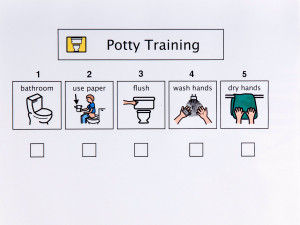Toilet Training: An SLPs perspective
- sharad367
- Mar 29, 2018
- 2 min read
Toilet Training: An SLPs perspective

Toilet Training is an important milestone for a child to achieve. Many parents would fret over this, especially when the child is getting ready to begin (play)school. Children are typically ready for toilet training around the age of two. A child’s physical and emotional readiness must be considered before beginning the training process.
As a Speech-language pathologist, I see many ways in which speech and language techniques can be used to assist the toilet training routine. Here is how:
1. Building an understanding about the toilet and the use of it is an important aspect of toilet training. Several ways to strengthen receptive skills (i.e. understanding) include
Labeling the toilet door.

Use a visual along with the name on the door of the toilet the child will be taken to. This will make sure s/he gets familiar with where s/he is being taken for passing urine or motion.
Preparing the child for toileting.
The child needs to know what is going to happen when s/he is being toilet trained. This means, preparing the child by reading books and/or using photos. Through them, talk to the child about how everyone uses the toilet from time to time. It should also explain how to tell when one needs to use the toilet, and that one is to sit on the seat, wash hands and even clean up after an accident.
Several books on potty training are available for children, however, you can always make your own and customize it to your child’s environment. Personally, I like making the book with the child and with photos of his own house and environment.
Keeping visuals ready.
There are several steps involved in using the toilet. It is easiest to have the steps visually available for the child to see while s/he is in the toilet. It can be shown through photos or drawings that the child can relate to.

Going over the photos/drawings before using the toilet or while using it, can be helpful to remind him/her what is to be done e.g. flushing toilet, washing hands, closing door etc.
2. While working on receptive skills, there is a need to have an avenue to let the child express the needs to use the toilet. It can be done in the following ways
Teaching gestures.
When a child is unable to use words to express a need, the use of gestures is quite important. Teaching the child simple gestures for ‘toilet’ can be one way to get him/ her to express himself when he needs to use it. It is important to let the child imitate the gesture, at first, every time s/he is taken to the toilet. Over time, the child may be able to pick up the same gestures and use it independently.
Hearing words about toileting, often.
The child needs to hear words about toileting consistently, whenever s/he is taken to use the toilet. This is important as it provides the child with the language environment needed for him/her to start using it in his / her own speech. Begin with simple words such as – toilet time, pee pee, poo, sit, flush, wash etc. With time, and as the child begins to use the simple words – move towards using phrases and then sentences e.g. Going to the toilet, Time to pee, Sit on the toilet (seat), etc. Don’t forget to use words of praise and reinforcements. This will be useful in the child using positive words him/herself.
Using words of emotions.
Many times, the use of emotional words is forgotten during the process of toilet training. It is, in my opinion, quite important to use these words – since a child may be feeling a lot of things. It may include words like – happy, embarrassed etc. Use them at appropriate times through the process, but importantly not in a way to ‘shame’ the child. By using these words, a child will start relating and then using them too.
Allow the child to use words of praise which are modeled by you. Praising the little steps towards being toilet trained is crucial. For instance, removing of pants/diapers, assisting in cleaning up a toilet accident – all requires praise. I would exaggerate my praise quite often, during the initial stages of toilet training and then, over time, space out my praises and bring it in for using the toilet.
Let these tips begin to guide the toilet training process. Good luck!
***
Tell us what’s worked for your child during the toilet training process? We’d love to hear from you.
***
Subscribe to us to receive more articles like this.




Comments